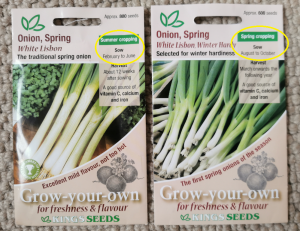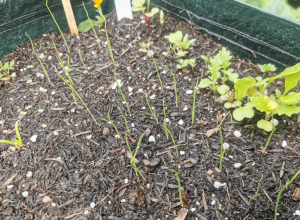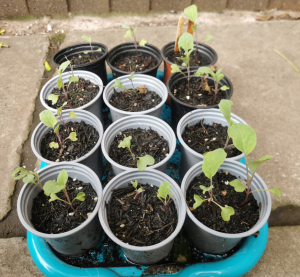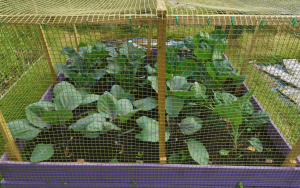
You might think that spring and summer are the only times of year to sow new seed to grow food, but autumn and winter are also great times to start crops off! There are some varieties of food that need starting now and will crop earlier next spring or be ready in the summer. Growing food all year round is a great way to reduce your food miles, eat locally produced food, and also reduces your shopping bill!
What Can You Sow Now?
August: Outdoors, you can direct sow winter hardy crops such as White Lisbon spring onion, and Winter Density lettuce. These can be sown from August to October, in a prepared growing bed/pot. You could also grow these indoors on a windowsill in trough planters. Corn salad (Lambs Lettuce) can also been sown from August to October. Sow the seeds directly where you want them to grow.
Make sure you use the right White Lisbon seeds! There are two types – an autumn sowing variety, and a winter sowing variety. Check the dates on the front of the packs (see photo below).
September: Late radishes can be sown outdoors, or indoors in planters on windowsills. Varieties include Cherry Belle, and a Mixed variety. We use Kings Seeds, and they are open to the public too. Radishes can be grown in hanging baskets, pots, the ground, or over fence planters.
All The Year Round cauliflower and Parthenon F1 calabrese (broccoli) can also be sown in September. Protect the seeds from slugs as they will munch the fresh leaves as they emerge. These are best started in pots and then potted on when they are about 10cm tall.
October: Certain types of peas and beans can be sown throughout this month, including the pea Douce Provence, and the broad beans Aquadulce Claudia, or De Monica.
Seed Spacing
Spring onion, lettuce and radishes can be grown indoors in pots or planters on windowsills, or in a greenhouse to give them some protection. They do not need pollinating to produce a crop.
Peas and beans produce flowers which is where the pod develops, so these need to be outdoors to enable pollination.
Spring onion can be sown quite close together, one seed every 2cm.
Lettuce needs room to develop the leaves and heart, so put one seed every 25-30cm.
Radishes also need room to swell as we eat the root part, so put one seed every 5cm.
Peas and broad beans put out a lot of leafy growth and like to climb, so make sure you give them some form of support either from a fence, trellis, canes, or a specific growing tower. Plant peas one seed every 5cm, and plant beans one seed every 15cm. Protect pea and bean seeds from mice and birds! You could start these seeds indoors under protection and then plant them out when the plants are 10cm tall.
Corn salad has very small seeds, so try and get one seed every 5cm. It doesn’t matter if you get two per hole, you can thin them out later.
Start the cauliflower and calabrese in pots. You could do two or three seeds per pot, and when they are about 10cm tall they will need to be put into individual pots to get bigger and stronger. When they have two or three sets of true leaves, they can be planted outdoors from March onwards. Make sure you protect them from birds and mice! If you decide to grow these in pots, they will need big (20-25cm) pots and one plant each. Protect each pot with netting to stop cabbage white butterflies getting on them to lay eggs on the leaves. The picture below is my cauliflower started earlier in August.
Plant Spacing
The cauliflower and calabrese plants will take up a lot of room when they have been planted out in March, so plant them about 45cm apart in each direction. They put out lots of leaves!
Time to Sow, Sow, Sow!
Where possible, use peat free compost. It can be more expensive, but it is better for the environment and for your plants. If you are sowing seeds directly into the ground, break up the soil so it doesn’t have lots of big lumps. Radishes and spring onions need softer soil so that the roots can swell.
Remember to label the seeds, and add an extra label with the date that you have sown them! This will help you to work out when you need to sow the next lot three weeks later.
Successional Sowing
Spring onion, lettuce, corn salad, and peas and beans can be sown every 3 or 4 weeks to give a successional cropping period – this means instead of getting a glut of lots of produce at the same time, you get a longer harvesting period as the seeds you sow now will be ready before the seeds you sow in October.
Radishes are at the end of their sowing period in September, so you only have time to sow some at the start and then some at the end. If you cover the soil/pot with a plastic lid it will warm the soil to aid germination, like a mini greenhouse.
Harvest Time and Harvesting
Harvest time for seeds sown in August and September will be from March onwards. Spring onions can be pulled when they are the thickness of a pencil or can be left longer to get bigger. You may need to use a hand fork or trowel to gently loosen the roots before pulling them – this prevents you from snapping them in two!
Lettuces will be ready from March too. Make sure you protect the plants with netting to stop the pigeons having a nibble. They should have a good solid heart before you pick them. Use a sharp knife to slice the heart off at ground level.
Radishes are ready to pull from around 4 or 5 weeks after sowing. Gently remove some of the soil from around the plant to see how big the root is. If it looks too small, leave them to grow. If they are about 3cm across, they are ready to pull. Seeds sown in September should be ready from the end of October onwards.
Peas are ready for harvesting from around May the following year. Broad beans should be ready from June onwards. Feel the pods and guesstimate how big the peas or beans are – they should feel firm and not squishy or full of air.
Cauliflower and calabrese will be ready in mid summer, so from around June onwards. Bend the innermost leaves over the developing bud to protect them from light and to stop the flower buds from bursting open – you want to grow nice tight flower heads. Use a strong knife to cut off the heads, or do a twist and pull motion. You can also use the leaves of brassicas in cooking – slice them up and add them to stir fry or bubble and squeak.
Crop Rotation
Peas and beans fix nitrogen into the soil which other crops do not like, so don’t plant spring onions and peas near each other, and do not plant spring onions in the ground where peas or beans have already been grown.
Lettuce, radish and spring onion can be planted near each other in a salad bed.
When you harvest the peas and beans, chop the stems off at ground level and leave the roots. This mean that the nitrogen nodules on the roots remain in the soil which works as a fertiliser.
Don’t grow brassicas in the same area two years running – this means the cauliflower and calabrese. They do like nitrogen so they can be planted where peas and beans were previously grown.
Companion Planting
Autumn isn’t really a time of year for growing flowers, so the number of companion plants is limited. If you already have nasturtium growing, these may continue to grow over the winter if it is warm enough or if the plants are sheltered. You could grow peas and beans amongst the nasturtium, but be careful that they don’t get swamped.
You could grow winter flowering pansies for a splash of colour between the rows of your food crops.
Quantities
Check the seed packet! The amount of seed in each pack is noted at the top. The winter lettuce seeds I have contains approx. 1,400 seeds, which is enough to last me for a few years. The calabrese Parthenon only has 50 seeds in a pack, which is enough for a couple of years if I choose to grow 15 each year, and to share amongst friends and family.
Grow the amount of food that you are likely to use to help reduce food waste. I grow lots of spring onions, corn salad, and peas, but I don’t like broad beans so I don’t grow any. Cauliflower and calabrese can take up a lot of room when they are growing so I only do 7 or 8 of each as that’s all I have room for.
Remember that if you are doing successional sowing, the crop will be harvested at different times. Don’t sow all the seeds at once!
Hints and Tips
If you have any questions, Laura is happy to answer them via email, Facebook or Twitter.
- Email: Laura.Hamilton@TCV.org.uk
- Facebook: Health For Life in the Community
- Twitter: TCV_Birmingham
Remember to share your pictures with us on Facebook and Twitter too!



